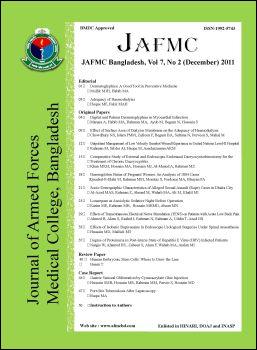Lorazepam As Anxiolytic Sedative Night Before Operation
DOI:
https://doi.org/10.3329/jafmc.v7i2.10392Keywords:
Lorazepam, diazepam, anxiolytic sedative, before operationAbstract
Introduction: Surgical patients have a high incidence of anxiety and there is a significant inverse relationship between anxiety and smoothness in induction of anaesthesia. The benzodiazepines are very effective at melting away the active terror of anxiety. Diazepam, a long acting benzodiazepine, is widely used by the anaesthesiologist to allay anxiety and provide sedation. The metabolism of diazepam is slow and is depressed by many factors such as old age, disease states (e.g. hepatic cirrhosis) and concomitant drug administration (e.g. cimetidine). Lorazepam, an intermediate acting benzodiazepine, is well absorbed orally. It is conjugated in the liver to the pharmacologically inactive glucuronide and its metabolism is less impaired by the above factors.
Objective: To compare the anxiolytic properties of lorazepam with diazepam before elective surgical procedures.
Method: One hundred patients of American Society of Anaesthesiologists (ASA) grade I and grade II, who were scheduled for general surgical, gynaecological operative procedures under general and regional anaesthesia in Combined Military Hospital, Saidpur Cantonment, during the period between June 2008 to June 2010, were included in this study. They were randomly distributed into two groups. Subjects of group A (n=50) received diazepam (Sedil) orally in a dose of 5 mg for <30 kg body weight or 10 mg for 30-70 kg body weight or 15 mg for >70 kg body weight. Subjects of group B (n=50) received lorazepam (Ativan) orally in a dose of 2 mg for <30 kg body weight or 4 mg for 30-70 kg body weight or 6 mg for >70 kg body weight. The effects of the two drugs as anxiolytic sedatives were compared on the basis of haemodynamic parameters, side effects and quality of sleep.
Results: There was no significant change in haemodynamic parameters between the two groups. Drugs on group B (Lorazepam group) were found to be more anxiolytic than drugs on group A (Diazepam group). Twenty percent of patients in diazepam group complained of moderate anxiety but it was absent in lorazepam group (p<0.01). Six percent of patients were restless/agitated in preoperative period in diazepam group, but it was absent in lorazepam group. Percentage of tranquil patients was significantly higher in lorazepam group (44%) than that in diazepam group (30%). Hangover effect was noted markedly in group B patients (44%) which was nil in group A patients (p<0.01), but it was beneficial for induction of anaesthesia. Moreover this hangover effect was significantly higher (p<0.01) in female population (50%) than in male population (21.05%). Some other side effects like nausea, vertigo were also noticed in patients of both groups and females were more susceptible to these side effects than males which might be an individual variation.
Conclusion: Considering all the factors, lorazepam appeared to be a better option than diazepam as anxiolytic sedative night before operation.
DOI: http://dx.doi.org/10.3329/jafmc.v7i2.10392
JAFMC 2011; 7(2): 25-28
Downloads
411
836

